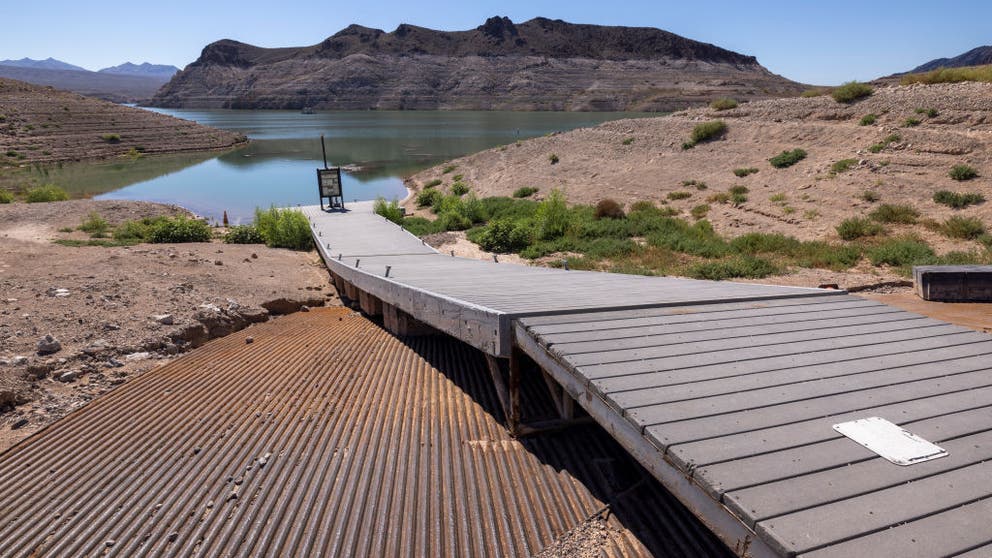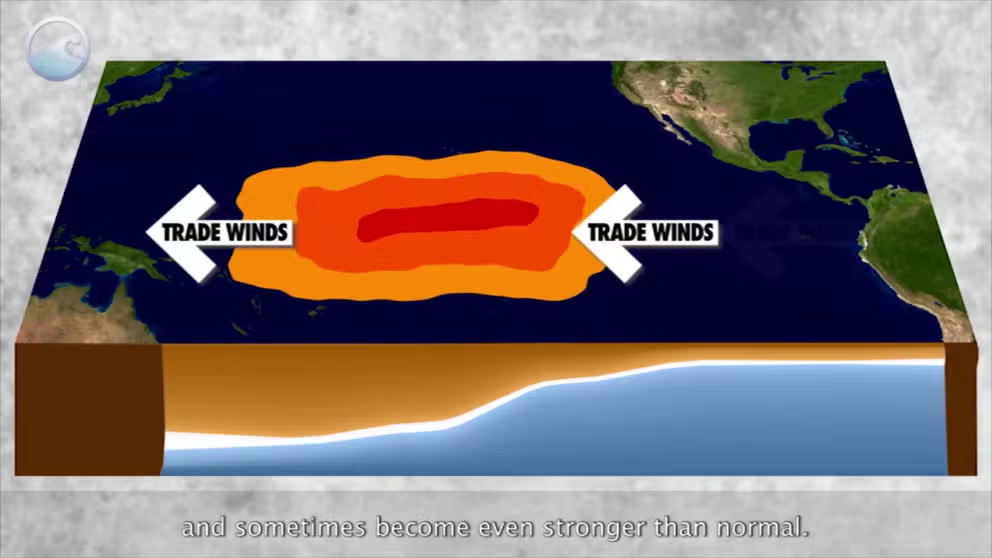US extends dubious record of 106 consecutive weeks with at least 40% of nation in drought
The National Drought Mitigation Center at the University of Nebraska says this past week once again extended a dubious record – 106 consecutive weeks with at least 40% of the U.S. mired in at least a moderate drought level.
'The Drought Mecca': National Drought Mitigation Center tracks 'on the ground' impacts
Scientists, researchers and climatologists at the University of Nebraska conduct groundbreaking research looking at drought to help save lives and economies. FOX Weather multimedia journalist Robert Ray with the latest from Lincoln, Nebraska.
LINCOLN, Neb. – The U.S. may be making headlines for heavy rain events this summer, but as a nation as a whole, the country very much remains mired in quite a bit of drought.
The National Drought Mitigation Center at the University of Nebraska says this past week once again extended a dubious record – 106 consecutive weeks (more than two years) with at least 40% of the U.S. mired in at least a moderate drought level.
The last time the national index for moderate drought dropped below 40% was on Sept. 29, 2020, when it was technically under by not rounding at 39.7%.
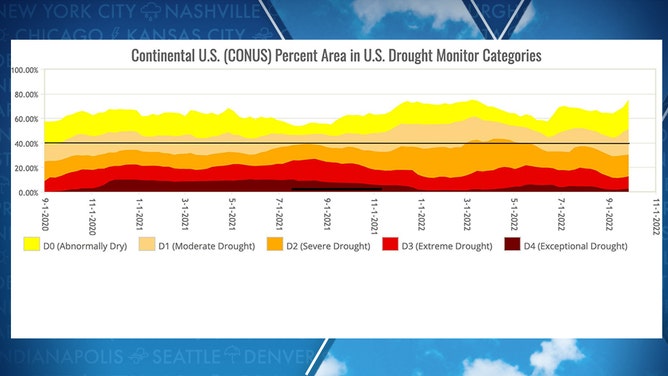
As of the latest Drought Monitor on Oct. 4, 44% of the U.S. and Puerto Rico, and almost 53% of the contiguous U.S., is in moderate drought or worse. It’s been 106 straight weeks with more than 40% of the Lower 48 in drought.
(National Drought Mitigation Center)
The drought stretch is far and away the longest such streak since data began monitoring in 2000. The previous longest streak was from June 2012 to October 2013 at 68 weeks. In third place is a 65-week stretch in 2002-03.
"Both of those earlier periods are recognized as some of the most severe droughts on record in the U.S.," according to NDMC spokesperson Leah Campbell.
Drought is as widespread as it is long
And it's not just in the Lower 48 where drought has been an issue. Puerto Rico just ended a 91-week stretch of drought when Hurricane Fiona brought over 30 inches of rain to some places.
HOW TO WATCH FOX WEATHER ON TV
Over in Hawaii, more than 90% of the state was in drought in August – a first for the Aloha State – and it persisted for four weeks, NDMC said.
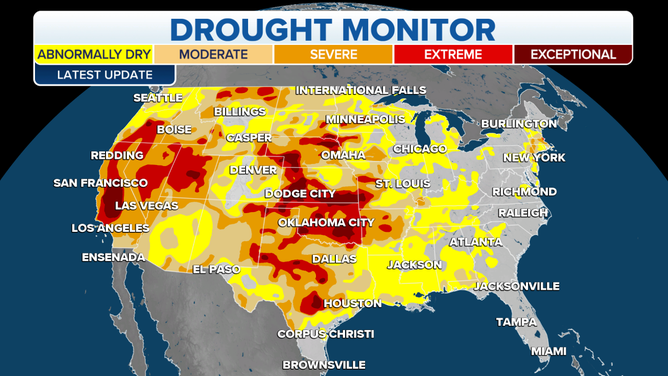
(FOX Weather)
A "moderate" drought is statistically classified as having an occurrence every 5- to 10-year period, meaning at any given point, the nation should be around 20% at most in that classification. Instead, the Lower 48 currently stands at 53% in moderate drought or worse.
"I’ve been involved with the Drought Monitor since the beginning and have seen a lot of U.S. droughts come and go," Brad Rippey, a meteorologist with the U.S. Department of Agriculture, told the NDMC. "The drought of 2020-2022 really stands out for its longevity. In 2012-2013, we were done with the worst of it in a little over a year."
La Niña a 'drought-maker'
Rippey blames the persistence of the drought on the back-to-back-to-back La Niña events – known as a rare "Triple Dip" La Niña.
La Niña, a condition when waters in the Central Pacific Ocean trend cooler than average, leads to changes across the globe that, for much of the U.S, leads to an overall drier-than-usual pattern.
LA NINA WINTER 2022-23 COULD MEAN TORNADO OUTBREAKS, BLIZZARDS AND EVERYTHING IN BETWEEN
The meaning of El Nino and La Nina
The status of whether the world is being impacted by an El Nino or a La Nina is determined by water temperatures in the Central and Eastern Pacific. (NOAA)
"In a general sense, when it comes to the U.S., La Niña is a drought-maker, while El Niño is a drought-breaker," said Rippey.
La Niña began in the second half of 2020 and is predicted to linger through the end of 2022, at least.
Only one state has escaped drought
Campbell says the drought has been widespread. For three weeks in mid-August, 44 states were at least partially in drought.
For the entire year, only one state hasn't been noted in some level of drought at some point in the year: Ohio.
The summer was particularly harsh for the Midwest with near-record heat contributing to an accelerated drought process. Oklahoma had its fifth-hottest July on record while Arkansas ranked seventh hottest, rapidly pushing the state into drought. In early June, just 2% of the state was in drought, while four weeks later that number ballooned to 89%.
Eight states in the Northeast and the Northwest all recorded their hottest August on record, and California had an extreme heat wave at the start of September that saw all-time high-temperature records shattered.
Nationally, this summer was the third-hottest June-to-August period on record, according to NDMC.
SUMMER 2022 FINISHES AS THIRD-WARMEST SEASON EVER WITH RECORDS SET ACROSS THE COUNTRY
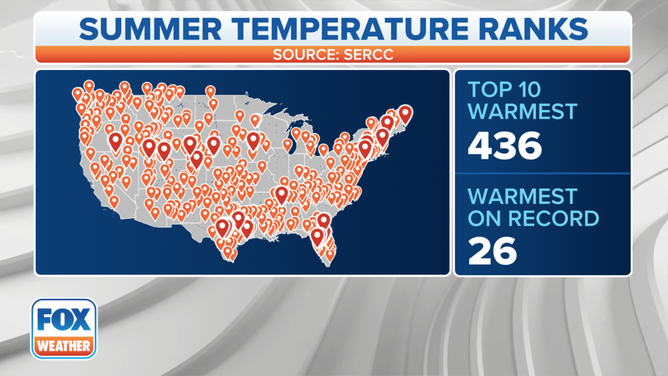
2022 summer temperature ranks.
(FOX Weather)
"This June was the 10th-hottest June on record. July was even worse," Campbell wrote. "It was the third-hottest July on record nationally, and almost every Western state hit top-10 records for heat for the month."
The NDMC says as of the Drought Monitor's last update on Oct. 4, over 125 million Americans were affected by drought, and the agency has received some 3,300 reports of drought-related impacts to cities, counties or states.
"Clearly something is happening to U.S. and global weather and climate patterns before our very eyes," Rippey told NDMC. "It's a very exciting time, but also a scary time to be a meteorologist. We may not know exactly what will happen, but all evidence says we can expect more extremes, including drought, going forward."
